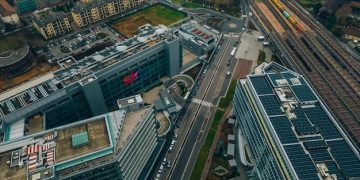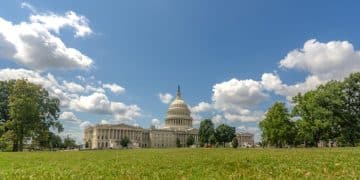Key Issues Facing US Local Governments in 2025

In 2025, local governments in the United States will face critical issues such as budget constraints, infrastructure challenges, housing affordability, climate change impacts, and evolving community needs, requiring innovative solutions and strong leadership.
Local governments across the United States are the backbone of communities, providing essential services and shaping the quality of life for residents. As we look ahead to 2025, it’s crucial to understand the key issues that will demand the attention of local leaders. This article delves into what are the key issues facing local governments in the United States in 2025, exploring the challenges and potential solutions.
Budget constraints and fiscal management
One of the most pressing concerns for local governments in 2025 will be managing strained budgets. Economic fluctuations, changing demographics, and increasing demands for services contribute to these financial pressures. Effective fiscal management is crucial for ensuring the sustainability of local government operations.
Strategies for budget optimization
Local governments must explore innovative ways to optimize their budgets. This includes identifying areas for cost savings, implementing efficient resource allocation strategies, and leveraging technology to streamline operations. Prioritization of essential services and careful evaluation of spending are essential steps.
Diversifying revenue streams
Relying solely on traditional sources of revenue, such as property taxes, can leave local governments vulnerable to economic downturns. Diversifying revenue streams through a mix of taxes, fees, and grants can provide a more stable financial foundation. Exploring public-private partnerships and alternative funding mechanisms can also help.
- Implement performance-based budgeting to allocate resources effectively.
- Explore opportunities for regional collaboration to share resources and reduce costs.
- Enhance revenue collection efforts to ensure compliance and maximize income.
- Invest in economic development initiatives to attract businesses and generate new tax revenue.

Effective budget constraints and fiscal management will require careful planning, innovative thinking, and a commitment to responsible stewardship of taxpayer dollars.
Infrastructure challenges and modernization
Aging infrastructure poses a significant challenge for local governments. Roads, bridges, water systems, and other vital infrastructure components require ongoing maintenance, repair, and modernization. Neglecting these needs can lead to costly failures and disruptions in essential services.
Assessing infrastructure needs
A comprehensive assessment of infrastructure needs is crucial for identifying priorities and developing a proactive maintenance plan. This involves evaluating the condition of existing infrastructure, projecting future demands, and estimating the costs of repair and replacement.
Investing in smart infrastructure
Smart infrastructure solutions leverage technology to improve efficiency, reduce costs, and enhance the resilience of critical systems. This includes implementing sensors, data analytics, and automation to monitor infrastructure performance and detect potential problems early on. Investing in smart grids, intelligent transportation systems, and water management technologies can yield significant benefits.
Modernizing infrastructure also involves incorporating sustainable design principles to reduce environmental impact and enhance the long-term viability of infrastructure assets. This includes using green building materials, implementing energy-efficient technologies, and promoting water conservation.
- Secure funding through federal and state grants and infrastructure bonds.
- Prioritize projects based on risk assessment and potential impact on public safety.
- Develop a long-term capital improvement plan to guide infrastructure investments.
Tackling infrastructure challenges and embracing modernization will require a strategic approach, collaboration with stakeholders, and a commitment to innovation.
Housing affordability and availability
The shortage of affordable housing is a growing crisis in many communities across the United States. Rising housing costs, stagnant wages, and limited supply are making it increasingly difficult for families and individuals to find safe, stable, and affordable housing. Local governments must address this issue to promote economic opportunity and social equity.
Strategies for increasing housing supply
Increasing the supply of affordable housing requires a multi-pronged approach. This includes incentivizing the construction of new housing units, streamlining the permitting process, and promoting mixed-income developments. Relaxing zoning regulations and allowing for greater density can also help to expand housing options.
Supporting affordable housing programs
Local governments can play a crucial role in supporting affordable housing programs through direct funding, tax incentives, and regulatory reforms. This includes partnering with non-profit organizations and community development corporations to develop and manage affordable housing projects. Providing rental assistance and housing vouchers can also help low-income families access safe and affordable housing.
Addressing housing affordability also requires addressing issues such as homelessness, housing discrimination, and displacement. Implementing policies that protect vulnerable populations and promote fair housing practices is essential.
- Explore innovative financing mechanisms, such as housing trust funds and impact investing.
- Encourage the development of accessory dwelling units (ADUs) to increase housing density.
- Implement inclusionary zoning policies to require developers to include affordable units in new developments.
Addressing the challenges of housing affordability and availability requires a comprehensive strategy, collaboration with stakeholders, and a commitment to creating inclusive communities.
Climate change resilience and sustainability
Climate change poses a significant threat to local governments and communities. Rising sea levels, extreme weather events, and changing environmental conditions can disrupt essential services, damage infrastructure, and threaten public health and safety. Local governments must take proactive steps to build resilience and promote sustainability.
Developing climate action plans
Developing a comprehensive climate action plan is crucial for identifying risks, setting goals, and implementing strategies to reduce greenhouse gas emissions and adapt to the impacts of climate change. This includes conducting vulnerability assessments, establishing emission reduction targets, and developing adaptation measures.
Promoting renewable energy and energy efficiency
Transitioning to renewable energy sources and improving energy efficiency are essential steps for reducing greenhouse gas emissions. Local governments can promote renewable energy by implementing policies that incentivize the development of solar, wind, and other renewable energy projects. Improving energy efficiency in buildings, transportation, and other sectors can also yield significant benefits.
Building climate resilience also requires investing in infrastructure improvements, such as flood control measures, seawalls, and upgraded water systems. Implementing land use policies that discourage development in vulnerable areas and promote green infrastructure can also help.
- Implement building codes that require energy-efficient construction.
- Invest in public transportation and encourage the use of electric vehicles.
- Promote water conservation and implement drought-resistant landscaping.
- Establish community gardens and support local food production.
Building climate change resilience and promoting sustainability requires a long-term commitment, collaboration with stakeholders, and a willingness to embrace innovation.
Evolving community needs and engagement
Local governments must adapt to the evolving needs of their communities. Changing demographics, technological advancements, and shifting social values are reshaping the demands and expectations of residents. Engaging with the community and responding to their needs is essential for building trust and ensuring effective governance.
Enhancing communication and transparency
Effective communication and transparency are crucial for building trust and fostering community engagement. Local governments can enhance communication by using a variety of channels, including social media, websites, and community meetings. Providing access to information and data and soliciting feedback from residents can also help to improve transparency.
Promoting civic participation
Encouraging civic participation is essential for ensuring that local government decisions reflect the needs and priorities of the community. This includes promoting voter registration, organizing town hall meetings, and creating opportunities for residents to serve on advisory boards and committees. Engaging with diverse communities and ensuring that all voices are heard is also crucial, and local governments should make sure everyone can have their voices heard through accessible meetings.

Addressing evolving community also requires promoting diversity, equity, and inclusion. Implementing policies that promote equal opportunities and address systemic inequalities is essential for creating a more just and equitable community.
- Invest in digital literacy programs to bridge the digital divide.
- Partner with community organizations to provide services and support to vulnerable populations.
- Implement participatory budgeting processes to involve residents in budget decisions.
Meeting evolving community needs and fostering engagement requires a proactive approach, a commitment to transparency, and a willingness to listen to the voices of residents.
Technological advancements and digital divide
Technological advancements are transforming the way local governments operate and deliver services. Embracing new technologies can improve efficiency, enhance communication, and provide residents with access to a wider range of services. However, the digital divide – the gap between those who have access to technology and those who do not – poses a significant challenge.
Investing in digital infrastructure
Investing in digital infrastructure is crucial for ensuring that all residents have access to high-speed internet and other essential technologies. This includes expanding broadband access, upgrading telecommunications networks, and providing public Wi-Fi hotspots. Local governments can partner with private sector companies and seek federal funding to support these investments. It would also be beneficial to allocate funding to provide devices to families lacking access to devices.
Providing digital literacy training
Providing digital literacy training is essential for helping residents develop the skills they need to use technology effectively. This includes offering classes, workshops, and online resources that teach basic computer skills, internet navigation, and digital safety. Local governments can partner with schools, libraries, and community centers to provide these training opportunities. This can also help older adults in the community learn how to connect with family members across the country.
Bridging the digital divide also requires addressing issues such as affordability, accessibility, and digital equity. Implementing policies that provide low-cost internet access, accessible technology, and inclusive digital design can help to ensure that all residents can benefit from technological advancements.
- Develop a digital inclusion plan to guide efforts to bridge the digital divide.
- Provide funding for digital literacy programs and technology training.
- Partner with community organizations to provide access to computers and internet services.
Addressing technological advancements and bridging the digital divide requires a comprehensive strategy, collaboration with stakeholders, and a commitment to digital equity.
| Key Issue | Brief Description |
|---|---|
| 💰 Budget Constraints | Managing limited funds and optimizing resource allocation. |
| 🌉 Infrastructure | Maintaining and modernizing aging infrastructure. |
| 🏠 Housing Affordability | Addressing the shortage of affordable housing options. |
| 🌍 Climate Change | Building resilience and promoting sustainability. |
Frequently asked questions
▼
The biggest challenge is likely managing budget constraints due to economic fluctuations and increasing service demands, requiring efficient fiscal management.
▼
Housing affordability affects economic opportunity and social equity, making it crucial for local governments to ensure safe, stable, and affordable housing.
▼
Local governments can develop climate action plans, promote renewable energy, and invest in resilient infrastructure to mitigate climate change impacts.
▼
Technology can improve service delivery and communication, but local governments must tackle the digital divide to ensure equitable access for all residents.
▼
Community engagement is vital for building trust and ensuring that government decisions reflect community needs and priorities, fostering effective governance.
Conclusion
Addressing the key issues facing local governments in the United States in 2025 will require proactive leadership, innovative solutions, and a commitment to collaboration. By prioritizing fiscal responsibility, infrastructure modernization, housing affordability, climate resilience, and community engagement, local governments can build stronger, more sustainable, and more equitable communities for all.





